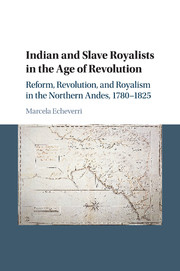 Indian and Slave Royalists in the Age of Revolution
Indian and Slave Royalists in the Age of Revolution Book contents
- Indian and Slave Royalists in the Age of Revolution
- Cambridge Latin American Studies
- Indian and Slave Royalists in the Age of Revolution
- Copyright page
- Contents
- Figures
- Table
- Acknowledgments
- Introduction
- 1 Reform, revolution, and royalism in the northern Andes
- 2 Indian politics and Spanish justice in eighteenth-century Pasto
- 3 The laws of slavery and the politics of freedom in late-colonial Popayán
- 4 Negotiating loyalty
- 5 Slaves in the defense of Popayán
- 6 “The yoke of the greatest of all tyrannical intruders, Bolívar”
- Conclusion
- Bibliography
- Index
- References
Bibliography
Published online by Cambridge University Press: 05 April 2016
- Indian and Slave Royalists in the Age of Revolution
- Cambridge Latin American Studies
- Indian and Slave Royalists in the Age of Revolution
- Copyright page
- Contents
- Figures
- Table
- Acknowledgments
- Introduction
- 1 Reform, revolution, and royalism in the northern Andes
- 2 Indian politics and Spanish justice in eighteenth-century Pasto
- 3 The laws of slavery and the politics of freedom in late-colonial Popayán
- 4 Negotiating loyalty
- 5 Slaves in the defense of Popayán
- 6 “The yoke of the greatest of all tyrannical intruders, Bolívar”
- Conclusion
- Bibliography
- Index
- References
- Type
- Chapter
- Information
- Indian and Slave Royalists in the Age of RevolutionReform, Revolution, and Royalism in the Northern Andes, 1780–1825, pp. 239 - 264Publisher: Cambridge University PressPrint publication year: 2016


